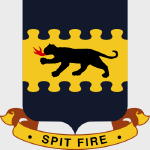Hobby Master HA1712 USAAF Bell P-39Q Airacobra Fighter - "Quanto Costa", 100th Fighter Squadron, Capodichino, Italy, 1944 (1:72 Scale)
"The four elements: earth, air, water, and fire. Of these, I call your attention to two: air and fire. Though it is your privilege to live in the air, you will die by fire."
- Major Sherman Joy, from the feature film, "The Tuskegee Airmen"
 The P-39 was one of America's first-line pursuit planes in December 1941. It made its initial flight in April 1939 at Wright Field and by the time of the Pearl Harbor attack, nearly 600 had been built. Its unique engine location behind the cockpit caused some pilot concern, but this proved to be no more of a hazard in a crash landing than with an engine located forward of the cockpit. However, the P-39's spin characteristics could be quite a problem if recovery techniques were ignored.
The P-39 was one of America's first-line pursuit planes in December 1941. It made its initial flight in April 1939 at Wright Field and by the time of the Pearl Harbor attack, nearly 600 had been built. Its unique engine location behind the cockpit caused some pilot concern, but this proved to be no more of a hazard in a crash landing than with an engine located forward of the cockpit. However, the P-39's spin characteristics could be quite a problem if recovery techniques were ignored.
The Airacobra saw combat throughout the world, particularly in the Southwest Pacific, Mediterranean and Russian theaters. Because its engine was not equipped with a supercharger, the P-39 performed best below 17,000 feet altitude, and it often was used at lower altitudes for such missions as ground strafing. When P-39 production ended in August 1944, Bell had built 9,584 Airacobras, of which 4,773 had been allotted to the Soviet Union. Russian pilots, in particular, liked the cannon-armed P-39 for its ground attack capability. Other P-39s served with French and British forces.
Pictured here is a 1:72 scale replica of a USAAF Bell P-39Q Airacobra fighter that was nicknamed "Quanto Costa" and attached to the 100th Fighter Squadron, then deployed to Capodichino, Italy, during 1944.
Sold Out!
Dimensions:
Wingspan: 5-3/4-inches
Length: 5-inches
Release Date: August 2011
 Historical Account: "Tuskegee Airmen" - The 100th was one of the Tuskegee Airmen squadrons during World War II, one of the famous all-black squadrons of the 332nd Fighter Group, activated on February 19th, 1942, at Tuskegee Army Air Field, Alabama, but which remained largely unmanned until it arrived at Selfridge Field, Michigan in late March 1943. There it received sufficient personnel and the squadron began operational training with P-39 and P-40 aircraft. The 100th completed training in December 1943 and prepared to move overseas.
Historical Account: "Tuskegee Airmen" - The 100th was one of the Tuskegee Airmen squadrons during World War II, one of the famous all-black squadrons of the 332nd Fighter Group, activated on February 19th, 1942, at Tuskegee Army Air Field, Alabama, but which remained largely unmanned until it arrived at Selfridge Field, Michigan in late March 1943. There it received sufficient personnel and the squadron began operational training with P-39 and P-40 aircraft. The 100th completed training in December 1943 and prepared to move overseas.
The squadron sailed in early January 1944 aboard the SS William Few and arrived in Italy in early February 1944, becoming part of the Twelfth Air Force, Mediterranean Theater of Operations (MTO). The 100th flew its first combat mission on February 19th, 1944. The squadron engaged in missions such as harbor protection, point-to-point patrol, convoy escort, armed reconnaissance, air rescue and strafing. In May 1944, the 100th was reassigned to the Fifteenth Air Force and thereafter the squadrons primary duty was providing escort for bombers striking enemy oil and industrial targets in central Europe and the Balkans. While initially equipped with P-39 and P-47 aircraft, in June 1944, the squadron received P-51 aircraft, which they used for the remainder of the war.
In August 1944, the unit attacked enemy positions on the French coast in preparation for the invasion of southern France. They escorted Fifteenth Air Force bombers in attacks on the assault beaches on August 15th, 1944. After this they returned to escorting heavy bombers to targets in Germany, Austria, Czechoslovakia, and Romania. They also attacked targets such as enemy airdromes, troop concentrations, communications lines, and enemy aircraft when the opportunity arose. The unit received a Distinguished Unit Citation for its performance during an escort to Berlin on March 23rd, 1945. The squadron, along with other squadrons of the 332nd Group, fought off a large enemy force, including jets, allowing the bomber formation to complete its mission. The 100th flew its last mission in Europe on April 30th, 1945. On September 30th, 1945, the 100th sailed for the United States aboard the Levi Woodbury and arrived at Camp Kilmer, NJ, on October 17th, 1945. The squadron was inactivated on October 19th, 1945.








![Israeli Defense Force Lockheed-Martin F-35A "Adir" Joint Strike Fighter - 140 Squadron "Golden Eagle", Nevatim Airbase, Beersheba, Israel, December 2017 [Low-Vis Scheme] (1:72 Scale)](http://cdn4.volusion.store/qh9e9-jdqv9/v/vspfiles/photos/HA4410-1.jpg?v-cache=1740197136)
